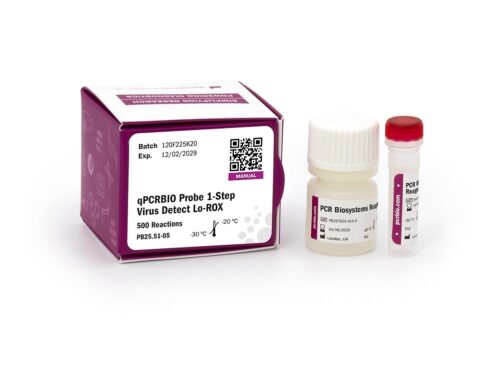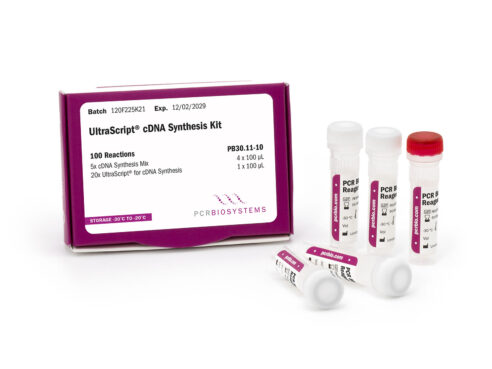qPCRBIO Probe 1-Step Go
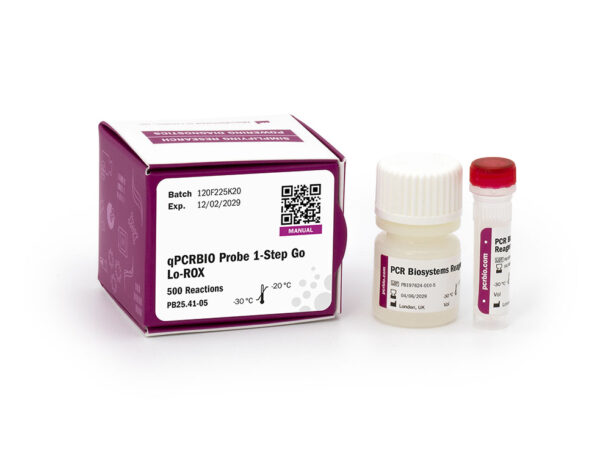
qPCRBIO Probe 1-Step Go is a universal probe kit designed for fast, highly specific and ultra-sensitive probe-based real-time RT-PCR.
The kit is engineered for use on a wide range of probe technologies including TaqMan®, Scorpions® and molecular beacon probes.
For most 1-step RT-qPCR applications we recommend trying our latest Clara® Probe 1-Step Mixes for best performance.
qPCRBIO Probe 1-Step Go is a universal probe kit designed for fast, highly specific and sensitive probe-based real-time RT-PCR. We use the latest developments in reverse transcriptase technology and buffer chemistry to give efficient cDNA synthesis and real-time PCR in a single tube.
Features
- Rapid and sensitive detection of RNA viruses including SARS-CoV-2
- Rapid extension rate for early Ct values
- Market-leading sensitivity – increased limit of detection
- High efficiency in multiplex reactions
- Advanced RNase inhibitor
- Antibody-mediated hot start PCR
- Compatible with all real-time PCR platforms – standard and fast cycling conditions
qPCRBIO Probe 1-Step Go is engineered for use on a wide range of probe technologies including TaqMan®, Scorpions® and molecular beacons probes. The kit includes a 2x mix and can be used to quantify any RNA template including mRNA, total RNA and viral RNA sequences. qPCRBIO Probe 1-Step Go is designed to give rapid and accurate results over a broad range of template concentrations and is ideally suited to the detection of RNA viruses including SARS-CoV-2.
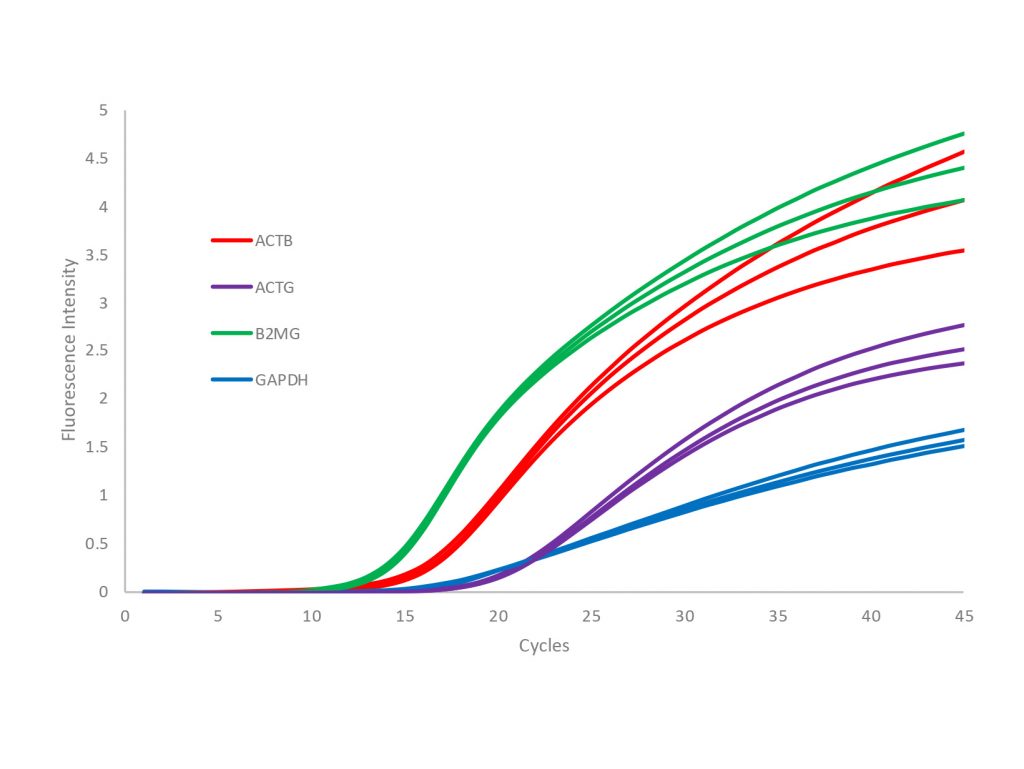
Applications
- Diagnostic real-time PCR
- Multiplex or singleplex
- Absolute quantification
- Relative gene expression analysis
- TaqMan®, Scorpions® and molecular beacon probes
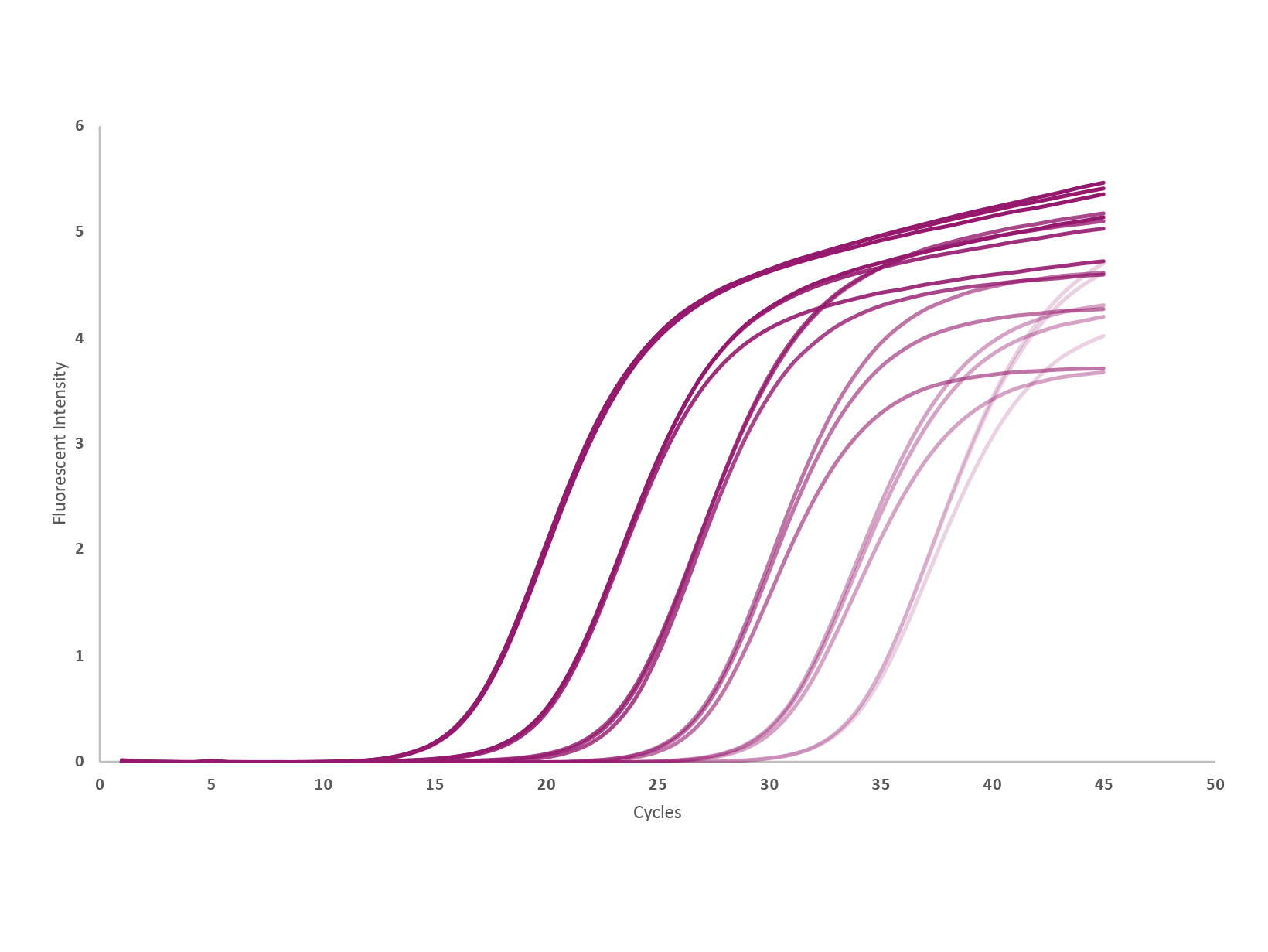
The kit includes a thermostable and extremely active modified MMLV reverse transcriptase (RTase Go) and advanced RNase inhibitor that prevents degradation of RNA by contaminating RNase. Antibody-mediated hot start technology prevents the formation of primer dimers and non-specific products giving highly specific and ultra-sensitive real-time RT-PCR with unrivalled efficiency in multiplex. Combining the latest developments in polymerase technology and advanced buffer chemistry we offer market-leading performance with minimal or no optimisation.
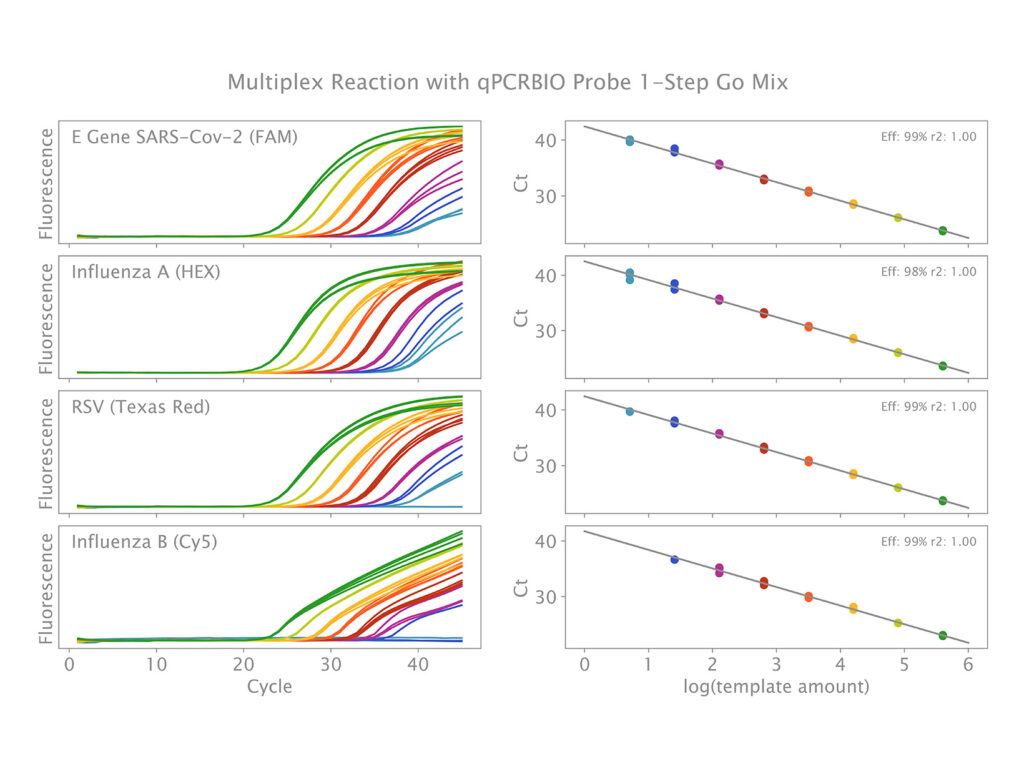
Related Links
Documents
Product Flyers
Product Manuals
Material Safety Data Sheets
Certificate of Analysis Finder
Specifications
qPCRBIO Probe 1-Step Go Lo-ROX
Component
100 Reactions
300 Reactions
500 Reaction
1200 Reactions
5000 Reactions
50000 Reactions
2x qPCRBIO Probe 1-Step Go Lo-ROX
1 x 1 mL
3 x 1 mL
1 x 5 mL
12 x 1 mL
1 x 50 mL
1 x 500 mL
20x RTase Go with RNase Inhibitor
1 x 100 μL
3 x 100 μL
1 x 500 μL
12 x 100 μL
1 x 5 mL
1 x 50 mL
qPCRBIO Probe 1-Step Go Hi-ROX
Component
100 Reactions
300 Reactions
500 Reactions
1200 Reactions
5000 Reactions
50000 Reactions
2x qPCRBIO Probe 1-Step Go Hi-ROX
1 x 1 mL
3 x 1 mL
1 x 5 mL
12 x 1 mL
1 x 50 mL
1 x 500 mL
20x RTase Go with RNase Inhibitor
1 x 100 μL
3 x 100 μL
1 x 500 μL
12 x 100 μL
1 x 5 mL
1 x 50 mL
qPCRBIO Probe 1-Step Go No-ROX
Component
100 Reactions
300 Reactions
500 Reactions
1200 Reactions
5000 Reactions
50000 Reactions
2x qPCRBIO Probe 1-Step Go No-ROX
1 x 1 mL
3 x 1 mL
1 x 5 mL
12 x 1 mL
1 x 50 mL
1 x 500 mL
20x RTase Go with RNase Inhibitor
1 x 100 μL
3 x 100 μL
1 x 500 μL
12 x 100 μL
1 x 5 mL
1 x 50 mL
qPCRBIO Probe 1-Step Go Separate-ROX
Component
100 Reactions
300 Reactions
500 Reactions
1200 Reactions
2x qPCRBIO Probe 1-Step Go No-ROX
1 x 1 mL
3 x 1 mL
1 x 5 mL
12 x 1 mL
20x RTase Go with RNase Inhibitor
1 x 100 μL
1 x 300 μL
1 x 500 μL
4 x 300 μL
50μM ROX Additive
1 x 200 μL
1 x 200 μL
1 x 200 μL
4 x 200 μL
qPCRBIO Probe 1-Step Go Lo-ROX
Component
2x qPCRBIO Probe 1-Step Go Lo-ROX
20x RTase Go with RNase Inhibitor
100 Reactions
1 x 1 mL
1 x 100 μL
300 Reactions
3 x 1 mL
3 x 100 μL
500 Reaction
1 x 5 mL
1 x 500 μL
1200 Reactions
12 x 1 mL
12 x 100 μL
5000 Reactions
1 x 50 mL
1 x 5 mL
50000 Reactions
1 x 500 mL
1 x 50 mL
qPCRBIO Probe 1-Step Go Hi-ROX
Component
2x qPCRBIO Probe 1-Step Go Hi-ROX
20x RTase Go with RNase Inhibitor
100 Reactions
1 x 1 mL
1 x 100 μL
300 Reactions
3 x 1 mL
3 x 100 μL
500 Reactions
1 x 5 mL
1 x 500 μL
1200 Reactions
12 x 1 mL
12 x 100 μL
5000 Reactions
1 x 50 mL
1 x 5 mL
50000 Reactions
1 x 500 mL
1 x 50 mL
qPCRBIO Probe 1-Step Go No-ROX
Component
2x qPCRBIO Probe 1-Step Go No-ROX
20x RTase Go with RNase Inhibitor
100 Reactions
1 x 1 mL
1 x 100 μL
300 Reactions
3 x 1 mL
3 x 100 μL
500 Reactions
1 x 5 mL
1 x 500 μL
1200 Reactions
12 x 1 mL
12 x 100 μL
5000 Reactions
1 x 50 mL
1 x 5 mL
50000 Reactions
1 x 500 mL
1 x 50 mL
qPCRBIO Probe 1-Step Go Separate-ROX
Component
2x qPCRBIO Probe 1-Step Go No-ROX
20x RTase Go with RNase Inhibitor
50μM ROX Additive
100 Reactions
1 x 1 mL
1 x 100 μL
1 x 200 μL
300 Reactions
3 x 1 mL
1 x 300 μL
1 x 200 μL
500 Reactions
1 x 5 mL
1 x 500 μL
1 x 200 μL
1200 Reactions
12 x 1 mL
4 x 300 μL
4 x 200 μL
Reaction Volume
Storage
20μL
On arrival, products should be stored between -30 and -20 °C. If stored correctly the kit will retain full activity until the indicated expiry date.
Reaction Volume
20μL
Storage
On arrival, products should be stored between -30 and -20 °C. If stored correctly the kit will retain full activity until the indicated expiry date.
Instrument Compatibility
This product is compatible with all standard and fast cycling qPCR instruments. Use our qPCR Selection Tool to find out which ROX variant is compatible with your instrument.
FAQs
What is the MgCl2 concentration in qPCRBIO Probe 1-Step Go mixes?
All qPCRBIO Probe 1-Step Go mixes contain MgCl2 at a concentration of 9 mM. This means the final concentration in the reaction is 4.5 mM.
Can ROX have a negative impact on the reaction?
ROX (6-carboxy-X-rhodamine) is used as a passive reference dye in ROX-dependent real-time PCR instruments to normalize for variations of fluorescence levels that can arise mainly due to optical path variations among wells. Normalisation of the fluorescence intensity (Rn) is done in real-time PCR software by dividing the emission intensity of the specific signal by the emission intensity of ROX.
ROX does not take part in the PCR reaction and its fluorescence levels are not proportional to the quantity of DNA in each well, so the addition of this fluorophore to a mix provides a constant fluorescent signal during amplification.
Different types of real-time PCR instruments requiring a passive reference standard have different optimal concentrations of ROX, mainly due to the different optical configurations of each system (i.e. the different type of excitation source and optics used).
The addition of either too little or too much ROX would result in a very noisy signal impacting on the results of the reaction. Therefore, it is extremely important for the user to:
- Determine the correct ROX concentration to optimise real-time PCR results, and
- Check the ROX settings on the software used to set up the reaction
A useful selection tool for the most commonly used systems can be found here.
What’s the difference between PCRBIO 1-Step Go RT-PCR Kit, qPCRBIO Probe 1-Step Go and qPCRBIO SyGreen 1-Step Detect|Go Kits?
The PCRBIO 1-step Go RT-PCR Kit has been developed for endpoint RT-PCR. The qPCRBIO Probe 1-Step Go and qPCRBIO SyGreen 1-Step Detect|Go are our probe- and dye-based options for real-time RT-PCR, respectively.
Do I need 1-step or 2-step reaction?
1-step
Both the cDNA synthesis and PCR reactions occur in the same mix. This option is suited for high throughput applications due to its speed and ease of set up. There is also a reduced risk of contamination. It is not ideal for low quality RNA samples or if the cDNA is required for archive or separate analysis.
2-step
The cDNA synthesis and PCR reactions occur separately. This option is better suited if the cDNA product needs to be retained for analysis. It also allows for higher levels of reaction optimisation. It permits control over the type and concentration of enzyme, RNA input and concentration of cDNA which, in turn, results in higher sensitivity compared to the 1-step format.
Can qPCRBIO Probe 1-Step Go be used for both 1-step and 2-step RT-PCR?
No, this kit will not work for 2-step reactions. For 2-step reactions, we recommend the UltraScript® cDNA Synthesis Kit (PB30.11) or UltraScript® 2.0 cDNA Synthesis Kit (PB30.31) for more difficult targets, along with real time PCR kits depending on your needs.
Can the activation time for the HS Taq DNA Polymerase be altered?
We recommend using a minimum of 2 minutes for activating the polymerase. Longer times of up to 15 minutes can also be used with no detrimental effects to the enzyme.
What priming method can I use?
Gene specific primers can be used in the 1-step reaction.
Will this work for micro RNA templates?
Yes, qPCRBIO Probe 1-Step Go can be used for micro RNA templates. Although we do no sell dedicated kits, all of our RTases can be used for miRNA quantification and analysis.
We advise that you use one of the two following approaches:
- Use universal RT primers and add poly(A) or poly(U) tails (e.g. by poly(U)-polymerase), followed by cDNA synthesis using universal primers1,2.
- Use specific RT primers and omit the tailing step1,3-5.
If you are unfamiliar with the specifics of those approaches, please refer to the reference list below, which serve as a guideline.
1 Dave, V. P. et al. MicroRNA amplification and detection technologies: opportunities and challenges for point of care diagnostics. Lab Invest 99, 452-469, doi:10.1038/s41374-018-0143-3 (2019).
2 Mei, Q. et al. A facile and specific assay for quantifying microRNA by an optimized RT-qPCR approach. PLoS One 7, e46890, doi:10.1371/journal.pone.0046890 (2012).
3 Chen, C. et al. Real-time quantification of microRNAs by stem-loop RT-PCR. Nucleic Acids Res 33, e179, doi:10.1093/nar/gni178 (2005).
4 Raymond, C. K., Roberts, B. S., Garrett-Engele, P., Lim, L. P. & Johnson, J. M. Simple, quantitative primer-extension PCR assay for direct monitoring of microRNAs and short-interfering RNAs. RNA 11, 1737-1744, doi:10.1261/rna.2148705 (2005).
5 Androvic, P., Valihrach, L., Elling, J., Sjoback, R. & Kubista, M. Two-tailed RT-qPCR: a novel method for highly accurate miRNA quantification. Nucleic Acids Res 45, e144, doi:10.1093/nar/gkx588 (2017).
What is ROX and do I need it?
ROX is a passive reference dye which means it does not take part in the PCR reaction. It is used to normalise non-PCR related fluctuations in fluorescence. You can use our qPCR Selection Tool under the Resources drop-down menu to determine which of our qPCR mixes are best suited for your qPCR machine.
What are the differences between probe and dye-based mixes?
Probe based kits such as qPCRBIO Probe 1-Step Go offer higher sensitivity and are unlikely to show non-template amplifications. Multiplexes can be measured using amplicons with different fluorophores for specific probes, which cannot be achieved using dyes.
Dye based systems such as qPCRBIO SyGreen 1-Step Detect | 1-Step Go detect any intact dsDNA and will therefore show primer dimers and off-target/non-template amplifications. These can be separated from product peaks by analysing melting curves.
Do I need to use an RNase inhibitor in my RT reaction?
No, the RTase Go contains an RNase inhibitor to prevent any degradation and increase sensitivity.
Beyond what Ct value are results unreliable?
Ct values can vary between template concentrations, reaction optimisation, instruments and laboratories so care must be taken when selecting a cut-off Ct value. Generally, Ct values over 35 would begin to be considered unreliable. However, late Cts could be observed for inefficient reactions using low template copy number. It is always good practice to normalise cut-offs with relative or absolute quantification methods. It is also recommended to run and analyse melt curves or gels of the products to determine products of any late amplifications
What should be considered when doing multiplex amplification?
The primers should be designed to ensure that they have similar annealing temperatures, are specific to the target, and do not form primer dimers. The primer/probe concentrations should not require adjustment unless the expression levels are significantly different. For highly expressed targets, the amount of primers should be decreased, and for targets expressed at lower levels it should be increased.
When performing a multiplex, what is the recommended concentration of each primer?
We recommend using 0.4 µM of each primer. There is a degree of flexibility around this recommended concentration however, the primer concentration should not be increased, as this may significantly affect the activity of the enzyme.
Is it normal if the fluorescence of qPCRBIO Probe Mixes differs from the one obtained with competitors’ products?
Different products could give a different plateau of fluorescence. However, this has no impact on quantification accuracy and Ct values will not differ among products.
Is mRNA isolation necessary for sensitive RT-PCR?
mRNA isolation is not normally required. qPCRBIO Probe 1-Step Go Kit has been developed to work on samples containing as little as 1 pg total RNA or 0.01 pg mRNA.
If you’re working with rare mRNA species, use a sequence-specific primer in the RT reaction to increase the sensitivity.
General troubleshooting for low product/late Ct values.
If you are observing unusually late Ct values, try diluting the template RNA. By doing this, you are diluting any inhibitors which may be present to a concentration where they do not inhibit the reaction. Additionally, try increasing the reverse transcription step to 55 °C and increasing the annealing/extension temperatures. This may help resolve difficulties caused by secondary structures present in the RNA template and/or primers.
In cases where reaction inhibition may be involved, try reducing the amount of template1 or add 0.4 – 4.4 mg/ml BSA to the reaction2.
For more specific problems contact [email protected] with the following information:
- Amplicon size
- Reaction setup
- Cycling conditions
- Screen grabs of amplification traces and melting profile
1 Scipioni et al. A SYBR Green RT-PCR assay in single tube to detect human and bovine noroviruses and control for inhibition. Virology Journal.5:94 (2008). doi: 1186/1743-422X-5-94
2 Plante et al. The use of bovine serum albumin to improve the RT‐qPCR detection of foodborne viruses rinsed from vegetable surfaces. Applied Microbiology. 52:3 (2010) doi: https://doi.org/10.1111/j.1472-765X.2010.02989.x
qPCRBIO Probe 1-Step Go is a universal probe kit designed for fast, highly specific and sensitive probe-based real-time RT-PCR. We use the latest developments in reverse transcriptase technology and buffer chemistry to give efficient cDNA synthesis and real-time PCR in a single tube.
Features
- Rapid and sensitive detection of RNA viruses including SARS-CoV-2
- Rapid extension rate for early Ct values
- Market-leading sensitivity – increased limit of detection
- High efficiency in multiplex reactions
- Advanced RNase inhibitor
- Antibody-mediated hot start PCR
- Compatible with all real-time PCR platforms – standard and fast cycling conditions
qPCRBIO Probe 1-Step Go is engineered for use on a wide range of probe technologies including TaqMan®, Scorpions® and molecular beacons probes. The kit includes a 2x mix and can be used to quantify any RNA template including mRNA, total RNA and viral RNA sequences. qPCRBIO Probe 1-Step Go is designed to give rapid and accurate results over a broad range of template concentrations and is ideally suited to the detection of RNA viruses including SARS-CoV-2.

Applications
- Diagnostic real-time PCR
- Multiplex or singleplex
- Absolute quantification
- Relative gene expression analysis
- TaqMan®, Scorpions® and molecular beacon probes

The kit includes a thermostable and extremely active modified MMLV reverse transcriptase (RTase Go) and advanced RNase inhibitor that prevents degradation of RNA by contaminating RNase. Antibody-mediated hot start technology prevents the formation of primer dimers and non-specific products giving highly specific and ultra-sensitive real-time RT-PCR with unrivalled efficiency in multiplex. Combining the latest developments in polymerase technology and advanced buffer chemistry we offer market-leading performance with minimal or no optimisation.

Related Links
Request a Quote & Sample
Your Selection:
Documents
Product Flyers
Product Manuals
Material Safety Data Sheets
Certificate of Analysis Finder
Specifications
qPCRBIO Probe 1-Step Go Lo-ROX
Component
100 Reactions
300 Reactions
500 Reaction
1200 Reactions
5000 Reactions
50000 Reactions
2x qPCRBIO Probe 1-Step Go Lo-ROX
1 x 1 mL
3 x 1 mL
1 x 5 mL
12 x 1 mL
1 x 50 mL
1 x 500 mL
20x RTase Go with RNase Inhibitor
1 x 100 μL
3 x 100 μL
1 x 500 μL
12 x 100 μL
1 x 5 mL
1 x 50 mL
qPCRBIO Probe 1-Step Go Hi-ROX
Component
100 Reactions
300 Reactions
500 Reactions
1200 Reactions
5000 Reactions
50000 Reactions
2x qPCRBIO Probe 1-Step Go Hi-ROX
1 x 1 mL
3 x 1 mL
1 x 5 mL
12 x 1 mL
1 x 50 mL
1 x 500 mL
20x RTase Go with RNase Inhibitor
1 x 100 μL
3 x 100 μL
1 x 500 μL
12 x 100 μL
1 x 5 mL
1 x 50 mL
qPCRBIO Probe 1-Step Go No-ROX
Component
100 Reactions
300 Reactions
500 Reactions
1200 Reactions
5000 Reactions
50000 Reactions
2x qPCRBIO Probe 1-Step Go No-ROX
1 x 1 mL
3 x 1 mL
1 x 5 mL
12 x 1 mL
1 x 50 mL
1 x 500 mL
20x RTase Go with RNase Inhibitor
1 x 100 μL
3 x 100 μL
1 x 500 μL
12 x 100 μL
1 x 5 mL
1 x 50 mL
qPCRBIO Probe 1-Step Go Separate-ROX
Component
100 Reactions
300 Reactions
500 Reactions
1200 Reactions
2x qPCRBIO Probe 1-Step Go No-ROX
1 x 1 mL
3 x 1 mL
1 x 5 mL
12 x 1 mL
20x RTase Go with RNase Inhibitor
1 x 100 μL
1 x 300 μL
1 x 500 μL
4 x 300 μL
50μM ROX Additive
1 x 200 μL
1 x 200 μL
1 x 200 μL
4 x 200 μL
qPCRBIO Probe 1-Step Go Lo-ROX
Component
2x qPCRBIO Probe 1-Step Go Lo-ROX
20x RTase Go with RNase Inhibitor
100 Reactions
1 x 1 mL
1 x 100 μL
300 Reactions
3 x 1 mL
3 x 100 μL
500 Reaction
1 x 5 mL
1 x 500 μL
1200 Reactions
12 x 1 mL
12 x 100 μL
5000 Reactions
1 x 50 mL
1 x 5 mL
50000 Reactions
1 x 500 mL
1 x 50 mL
qPCRBIO Probe 1-Step Go Hi-ROX
Component
2x qPCRBIO Probe 1-Step Go Hi-ROX
20x RTase Go with RNase Inhibitor
100 Reactions
1 x 1 mL
1 x 100 μL
300 Reactions
3 x 1 mL
3 x 100 μL
500 Reactions
1 x 5 mL
1 x 500 μL
1200 Reactions
12 x 1 mL
12 x 100 μL
5000 Reactions
1 x 50 mL
1 x 5 mL
50000 Reactions
1 x 500 mL
1 x 50 mL
qPCRBIO Probe 1-Step Go No-ROX
Component
2x qPCRBIO Probe 1-Step Go No-ROX
20x RTase Go with RNase Inhibitor
100 Reactions
1 x 1 mL
1 x 100 μL
300 Reactions
3 x 1 mL
3 x 100 μL
500 Reactions
1 x 5 mL
1 x 500 μL
1200 Reactions
12 x 1 mL
12 x 100 μL
5000 Reactions
1 x 50 mL
1 x 5 mL
50000 Reactions
1 x 500 mL
1 x 50 mL
qPCRBIO Probe 1-Step Go Separate-ROX
Component
2x qPCRBIO Probe 1-Step Go No-ROX
20x RTase Go with RNase Inhibitor
50μM ROX Additive
100 Reactions
1 x 1 mL
1 x 100 μL
1 x 200 μL
300 Reactions
3 x 1 mL
1 x 300 μL
1 x 200 μL
500 Reactions
1 x 5 mL
1 x 500 μL
1 x 200 μL
1200 Reactions
12 x 1 mL
4 x 300 μL
4 x 200 μL
Reaction Volume
Storage
20μL
On arrival, products should be stored between -30 and -20 °C. If stored correctly the kit will retain full activity until the indicated expiry date.
Reaction Volume
20μL
Storage
On arrival, products should be stored between -30 and -20 °C. If stored correctly the kit will retain full activity until the indicated expiry date.
Instrument Compatibility
This product is compatible with all standard and fast cycling qPCR instruments. Use our qPCR Selection Tool to find out which ROX variant is compatible with your instrument.
FAQs
What is the MgCl2 concentration in qPCRBIO Probe 1-Step Go mixes?
All qPCRBIO Probe 1-Step Go mixes contain MgCl2 at a concentration of 9 mM. This means the final concentration in the reaction is 4.5 mM.
Can ROX have a negative impact on the reaction?
ROX (6-carboxy-X-rhodamine) is used as a passive reference dye in ROX-dependent real-time PCR instruments to normalize for variations of fluorescence levels that can arise mainly due to optical path variations among wells. Normalisation of the fluorescence intensity (Rn) is done in real-time PCR software by dividing the emission intensity of the specific signal by the emission intensity of ROX.
ROX does not take part in the PCR reaction and its fluorescence levels are not proportional to the quantity of DNA in each well, so the addition of this fluorophore to a mix provides a constant fluorescent signal during amplification.
Different types of real-time PCR instruments requiring a passive reference standard have different optimal concentrations of ROX, mainly due to the different optical configurations of each system (i.e. the different type of excitation source and optics used).
The addition of either too little or too much ROX would result in a very noisy signal impacting on the results of the reaction. Therefore, it is extremely important for the user to:
- Determine the correct ROX concentration to optimise real-time PCR results, and
- Check the ROX settings on the software used to set up the reaction
A useful selection tool for the most commonly used systems can be found here.
What’s the difference between PCRBIO 1-Step Go RT-PCR Kit, qPCRBIO Probe 1-Step Go and qPCRBIO SyGreen 1-Step Detect|Go Kits?
The PCRBIO 1-step Go RT-PCR Kit has been developed for endpoint RT-PCR. The qPCRBIO Probe 1-Step Go and qPCRBIO SyGreen 1-Step Detect|Go are our probe- and dye-based options for real-time RT-PCR, respectively.
Do I need 1-step or 2-step reaction?
1-step
Both the cDNA synthesis and PCR reactions occur in the same mix. This option is suited for high throughput applications due to its speed and ease of set up. There is also a reduced risk of contamination. It is not ideal for low quality RNA samples or if the cDNA is required for archive or separate analysis.
2-step
The cDNA synthesis and PCR reactions occur separately. This option is better suited if the cDNA product needs to be retained for analysis. It also allows for higher levels of reaction optimisation. It permits control over the type and concentration of enzyme, RNA input and concentration of cDNA which, in turn, results in higher sensitivity compared to the 1-step format.
Can qPCRBIO Probe 1-Step Go be used for both 1-step and 2-step RT-PCR?
No, this kit will not work for 2-step reactions. For 2-step reactions, we recommend the UltraScript® cDNA Synthesis Kit (PB30.11) or UltraScript® 2.0 cDNA Synthesis Kit (PB30.31) for more difficult targets, along with real time PCR kits depending on your needs.
Can the activation time for the HS Taq DNA Polymerase be altered?
We recommend using a minimum of 2 minutes for activating the polymerase. Longer times of up to 15 minutes can also be used with no detrimental effects to the enzyme.
What priming method can I use?
Gene specific primers can be used in the 1-step reaction.
Will this work for micro RNA templates?
Yes, qPCRBIO Probe 1-Step Go can be used for micro RNA templates. Although we do no sell dedicated kits, all of our RTases can be used for miRNA quantification and analysis.
We advise that you use one of the two following approaches:
- Use universal RT primers and add poly(A) or poly(U) tails (e.g. by poly(U)-polymerase), followed by cDNA synthesis using universal primers1,2.
- Use specific RT primers and omit the tailing step1,3-5.
If you are unfamiliar with the specifics of those approaches, please refer to the reference list below, which serve as a guideline.
1 Dave, V. P. et al. MicroRNA amplification and detection technologies: opportunities and challenges for point of care diagnostics. Lab Invest 99, 452-469, doi:10.1038/s41374-018-0143-3 (2019).
2 Mei, Q. et al. A facile and specific assay for quantifying microRNA by an optimized RT-qPCR approach. PLoS One 7, e46890, doi:10.1371/journal.pone.0046890 (2012).
3 Chen, C. et al. Real-time quantification of microRNAs by stem-loop RT-PCR. Nucleic Acids Res 33, e179, doi:10.1093/nar/gni178 (2005).
4 Raymond, C. K., Roberts, B. S., Garrett-Engele, P., Lim, L. P. & Johnson, J. M. Simple, quantitative primer-extension PCR assay for direct monitoring of microRNAs and short-interfering RNAs. RNA 11, 1737-1744, doi:10.1261/rna.2148705 (2005).
5 Androvic, P., Valihrach, L., Elling, J., Sjoback, R. & Kubista, M. Two-tailed RT-qPCR: a novel method for highly accurate miRNA quantification. Nucleic Acids Res 45, e144, doi:10.1093/nar/gkx588 (2017).
What is ROX and do I need it?
ROX is a passive reference dye which means it does not take part in the PCR reaction. It is used to normalise non-PCR related fluctuations in fluorescence. You can use our qPCR Selection Tool under the Resources drop-down menu to determine which of our qPCR mixes are best suited for your qPCR machine.
What are the differences between probe and dye-based mixes?
Probe based kits such as qPCRBIO Probe 1-Step Go offer higher sensitivity and are unlikely to show non-template amplifications. Multiplexes can be measured using amplicons with different fluorophores for specific probes, which cannot be achieved using dyes.
Dye based systems such as qPCRBIO SyGreen 1-Step Detect | 1-Step Go detect any intact dsDNA and will therefore show primer dimers and off-target/non-template amplifications. These can be separated from product peaks by analysing melting curves.
Do I need to use an RNase inhibitor in my RT reaction?
No, the RTase Go contains an RNase inhibitor to prevent any degradation and increase sensitivity.
Beyond what Ct value are results unreliable?
Ct values can vary between template concentrations, reaction optimisation, instruments and laboratories so care must be taken when selecting a cut-off Ct value. Generally, Ct values over 35 would begin to be considered unreliable. However, late Cts could be observed for inefficient reactions using low template copy number. It is always good practice to normalise cut-offs with relative or absolute quantification methods. It is also recommended to run and analyse melt curves or gels of the products to determine products of any late amplifications
What should be considered when doing multiplex amplification?
The primers should be designed to ensure that they have similar annealing temperatures, are specific to the target, and do not form primer dimers. The primer/probe concentrations should not require adjustment unless the expression levels are significantly different. For highly expressed targets, the amount of primers should be decreased, and for targets expressed at lower levels it should be increased.
When performing a multiplex, what is the recommended concentration of each primer?
We recommend using 0.4 µM of each primer. There is a degree of flexibility around this recommended concentration however, the primer concentration should not be increased, as this may significantly affect the activity of the enzyme.
Is it normal if the fluorescence of qPCRBIO Probe Mixes differs from the one obtained with competitors’ products?
Different products could give a different plateau of fluorescence. However, this has no impact on quantification accuracy and Ct values will not differ among products.
Is mRNA isolation necessary for sensitive RT-PCR?
mRNA isolation is not normally required. qPCRBIO Probe 1-Step Go Kit has been developed to work on samples containing as little as 1 pg total RNA or 0.01 pg mRNA.
If you’re working with rare mRNA species, use a sequence-specific primer in the RT reaction to increase the sensitivity.
General troubleshooting for low product/late Ct values.
If you are observing unusually late Ct values, try diluting the template RNA. By doing this, you are diluting any inhibitors which may be present to a concentration where they do not inhibit the reaction. Additionally, try increasing the reverse transcription step to 55 °C and increasing the annealing/extension temperatures. This may help resolve difficulties caused by secondary structures present in the RNA template and/or primers.
In cases where reaction inhibition may be involved, try reducing the amount of template1 or add 0.4 – 4.4 mg/ml BSA to the reaction2.
For more specific problems contact [email protected] with the following information:
- Amplicon size
- Reaction setup
- Cycling conditions
- Screen grabs of amplification traces and melting profile
1 Scipioni et al. A SYBR Green RT-PCR assay in single tube to detect human and bovine noroviruses and control for inhibition. Virology Journal.5:94 (2008). doi: 1186/1743-422X-5-94
2 Plante et al. The use of bovine serum albumin to improve the RT‐qPCR detection of foodborne viruses rinsed from vegetable surfaces. Applied Microbiology. 52:3 (2010) doi: https://doi.org/10.1111/j.1472-765X.2010.02989.x




